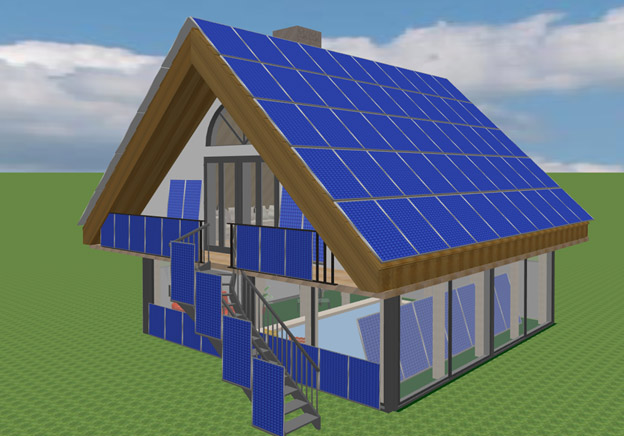It will become apparent right away that this is not an actual architectural project. Instead, it’s a somewhat sensible, futuristic model that explores the concept of turning your house into a solar power station.
Let’s try to rationally answer the question of what if, using our experience below.
Introduction
Ever since humans found themselves on Earth, we’ve built houses. As a result, we have literally hundreds of thousands of years of building experience. Many designs have been developed over the years that are best suited to different climatic zones, and you may be forgiven for thinking it’s impossible to come up with anything new. Technological progress has recently accelerated so fast that the average consumer can no longer master all the new products that constantly hit the market.
As an example, take human technological advances in solar power. If you place rows of solar cells on the roof of your home, no one will even look twice. Technology that seemed like science fiction barely a decade ago, is now commonplace in suburbia. Taking this into consideration, let’s dig a little deeper – Let’s rethink the whole structure of a house from the standpoint of maximizing autonomous power generation via the introduction of solar cells into its core design.
Let’s move forward and now explore what would happen if we were to turn a private house into a solar power station? A self-sufficient dwelling that generates solar electricity, taking full advantage of the structure’s surface area. Being a concept, we’re able to ruthlessly discard any traditional, non-structural components of the house that will not assist in generating solar energy and make changes as we see fit.
By approaching the process of turning your house into a solar power station wisely, that is, by optimizing the process, then it becomes entirely possible to lower your building costs. Not only will the external elements of the house not consume your annual maintenance funds, the structure will actually allow you to reap rewards every day in the form of generated electricity! This can be achieved by redesigning the house so that solar cells partially replace traditional structural elements.
Let’s start by considering how an ordinary residential home would change if we dissect it to reach our goals. To keep things simple, let’s use a house for two to four people as our concept home. Think of an average sized house for a young family with a couple of children, or possibly one for an elderly retired couple. While you may logically assume a house for a small family is one-story, we’ve taken some artistic license and gone with a multi-story approach. Purely because we like the idea of a basement and attic being included to maximize the space available. While a one-story housing project with a flat roof would also work, we’ve decided that this design is unsuitable, since in winter the solar panels may be covered with snow, further complicating the process. Complications that are contrary to the primary idea behind this article – not adding anything and only using existing structural elements. As you’ll see when we get further into the design, you’ll see we’ve actually removed the entire first floor and taken advantage of the space in a slightly different manner.
This building can be described as a “soil-foundation-walls-roof” system, so let’s dive right in and start moving through the home’s components.
1. Ground and foundation.
When considering the soils found at most development sites, most are poorly adapted for construction. Often in modern private construction, we see the soil removal and leveling process allow for basements to be built. These can however add unnecessary costs to the project and proper cost/benefit analysis should be carried out before going down this path at the first stage of construction.
For this particular project we’re not going down this path. Instead, we will still use structural pylons that run from the ground to ceiling.
For this idea, we’ve considered the foundations that go into modern high-rise construction. We see high-rise buildings today even standing steady on quicksand! Modern high-rise buildings stand on pylons that rise into the sky, helping to distribute the weight of reinforced concrete ceilings that also act as the second floor.
Our design is strong, rigid, and even earthquake-resistant. For our family home design concept, this is obviously more than suitable but it’s better to be safe than sorry. Furthermore, integrating pylons into the design as we have allows us to be extremely tolerant of the flakey nature of substandard soils.
In the following section, we take this technology as a basis.
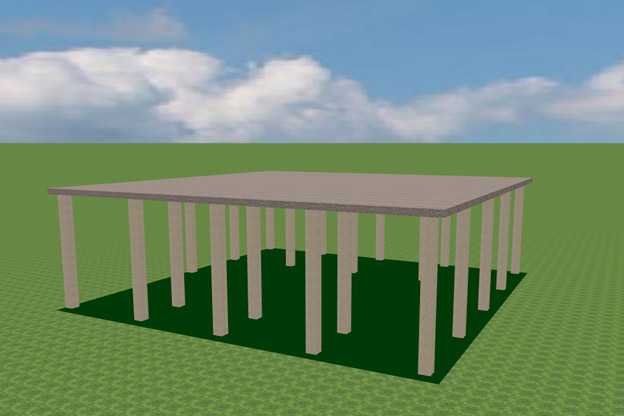
So what exactly does this give us? A design that features a series of pylons that are protected from the elements. Both cheaper to implement and more functional than a solid concrete basement. It’s actually not that difficult to make pylons for private houses in this manner. Just two or three workers with a concrete mixer and a welding machine would suffice.
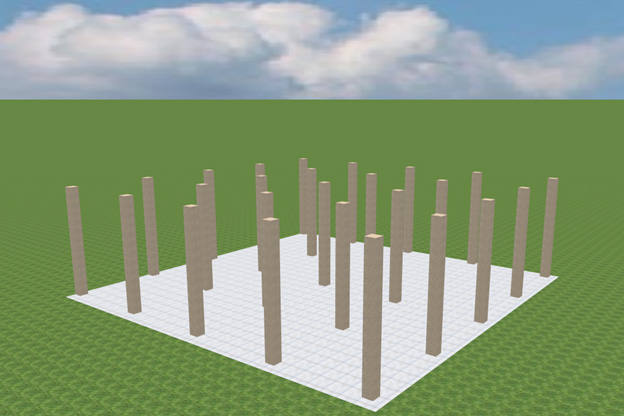
Double-glazed windows are then very easily installed between the pylons, work that comes out again much cheaper when compared to reinforced concrete work, giving us a bright hall under the house. This space could be used as a greenhouse, garage, cafe, swimming pool or workshop. But most importantly for our concept, it allows us to install further solar panels!
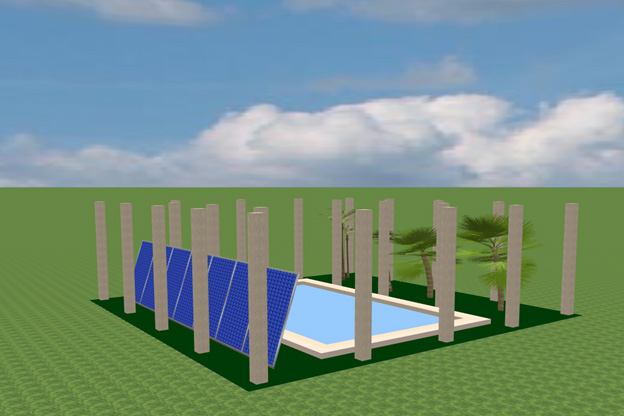
Depending on your final design choice dictated by how the space will ultimately be used, you can leave the dirt floor or simply fill it with gravel. An immeasurably cheaper route than using reinforced concrete foundations. In our case, it will be necessary to build a shallow, self-supporting reinforced concrete foundation under the rows of glass walls. A couple of low-skilled builders can undertake this work with limited time required. The role of this foundation is to prevent the windows from bending under their own weight and ultimately serve as a barrier against moisture, rodents and insects. As a result, overbearing strength is not required here. It can even be made from ready-made structures such as inexpensive, standardized sections of concrete fences.
Instead of gloomy stone walls that require insulation, plastering or painting, we end up with a modern high-tech and highly durable facade. Most importantly, a facade that doesn’t cost a lot of money to maintain and instead actually produces electricity for the home every single day.
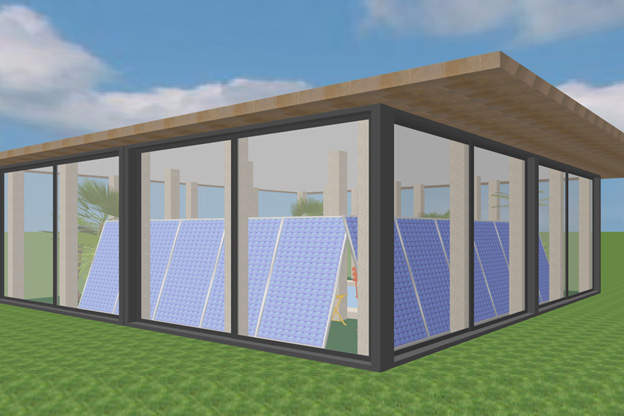
These lower level glass walls require little to no maintenance other than occasional dusting or hosing-down. While there are security and privacy drawbacks of using glass in this manner, we would argue that the pros far outweigh the cons. When you consider where modern video surveillance and other security tech systems are at, you can certainly find peace, no matter where on the planet you decide to build this solar power station house of the future. Any privacy concerns can likewise be easily addressed. For example, the external walls can actually be made of opaque glass. Remember our primary goal of building a solar power station and therefore we want to maximize the natural heating properties of the sun in order to limit wasting production. Furthermore, we want to take advantage of all external surfaces by placing solar panels to generate electricity. Thus adding a further privacy barrier between you and the outside world. The scope to use our imagination is unlimited – any combination of internal and external solar panels with protective shutters and blinds is possible at the discretion of the owner.
A further consideration is the option to place the solar panels on the outer surface of the glass, automatically turning them into protective fences for privacy. This also corresponds with the primary goal of our concept home – to increase the functionality of solar panels, which in this case perform the role of privacy blinds.
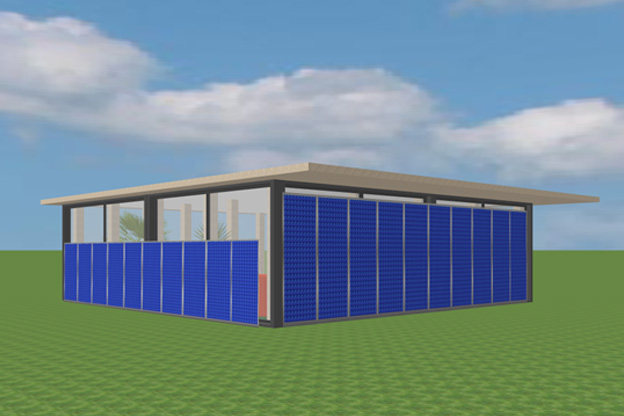
If multi-chamber double-glazed windows are installed in lower-story buildings such as this, then heat losses can also be minimized. The heat of the earth will serve as a base, evening out daily temperature fluctuations. This system can eventually even stabilize in such a way that any heat lost during the night will be compensated by daytime solar radiation. Thus ensuring a consistently mild temperature throughout both the day and night. The idea is that we essentially have a semiconductor diode – heat from the sun enters through the transparent walls before accumulating in the earthen floor. The heat is then trapped because it encounters strong resistance from multi-chamber glazing at the glass walls.
At this point, we have not even taken into account the work of our solar panels! If connected during the day, for example to infrared emitters aimed at the floor surface, then you will receive a good supply of heat to compensate for nighttime cooling. Excess energy can then be distributed between floors, both for heating and for other domestic needs. If the house is located in a very cold climate zone and is periodically heated by a stove, then thanks to our double-glazed basement, heating will occur even quicker than normal. Best of all however, the heat will be retained for longer due to the multi-chamber design of our transparent walls.
A further additional way of accumulating energy is to build a heated swimming pool in the center of the lower level room that is warmed by heaters connected to external facing solar panels. Water, which is famous for its heat capacity, will actually act as an even more significant store of heat than the earth itself.
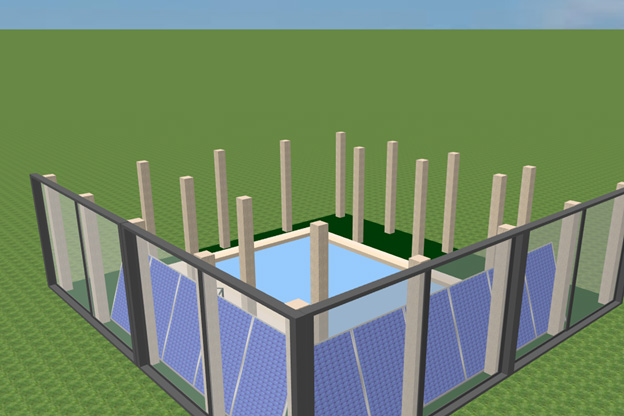
The heat capacity of water can be illustrated by referring to old military technology. We remember that air-cooled machine guns actually overheated quite quickly and required interchangeable barrels in a protracted battle. Water-cooled machine guns on the other hand, were able to remain cooler for longer and thus retained their combat effectiveness. From this example, it can be seen that water is able to contain a huge amount of heat. Suppose that in this pool in the basement there will be a temperature of about 30 degrees Celsius. If so, the temperature in the room will be stabilized by this pool at 25 degrees, as a heat accumulator, protecting the space from wild daily temperature fluctuations.
At this point, it becomes entirely up to the owners whether they want to use the pool to swim in, or for breeding heat-loving fish and amphibians for an additional income. Furthermore, if tropical vegetation grows around the pool, then it will also create a comfortable environment for plants. Underwater plants are another interesting area that can be explored by exotic interior designers.
If lotuses are grown in the pool, then meditation sessions for divers can be held in it. At this point, it is obvious that this space would absolutely be one of a kind.
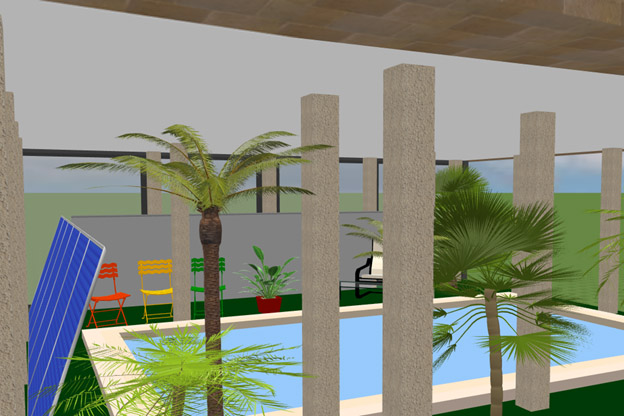
In order to take maximum advantage of the sun, Solar panels can be placed on the east, south and west sides of the building.
Moving forward, let’s now consider this design from a material and technological cost point of view during construction. Imagine that this lower floor was built according to the classical scheme adopted in many countries within the post-Soviet space.
An ordinary developer usually starts with earthworking machinery – digging a pit or trench below the freezing depth, which on average is about one and a half meters. This requires the use of an excavator or a bulldozer. In our case however, as the load bearing pylons are located inside and are not exposed to low temperatures externally, we do not need to go so deep. It is more than enough for us to simply dig to a desired depth calculated on soil properties and building weight.
Of course, if the owner decides to build a solar power station house in a swamp, then the pylons will then require to be placed at a further depth in order to become stable. This is all down to the numerous molecular bonds found within peat and in this case, the idea of a pool would become problematic.
Our pylons inside the lower level, which have actually grown from pylons into columns, have additional useful properties – it is easy to install partitions between them, both solid and openwork, meaning they can serve as a support for both solar panels or interior items.
External glazing from multi-chamber double-glazed windows can be installed both in plastic frames provided by a window manufacturer, or within other heat-insulating structures. These can be wooden frames made of thick timber, or columns made of other modern thermal insulation materials. Since glazing occupies the bulk of the walls, the cost of various frames will be negligible. Unlike traditional stone or frame walls, energy-saving multi-chamber walls are practical and thus not subject to atmospheric influences. Another very important advantage being the speed at which they can be constructed. Keep in mind that the installation of transparent walls in this manner is much faster than traditional earthen and reinforced concrete nightmares.
2. Residential floor.
Now we move on to the second and third levels where most of the living will be done. Before we go, let’s just make note of one more important aspect of our base at the ground floor. Did you know that the warmest air in the room is located directly under the ceiling, at a distance of 5-10 centimeters from its surface? This is extremely annoying for residents of multi-storey apartment buildings because the warmth is out of reach of the ground floor, instead being wasted on the neighbors above. But in the case of our solar power station house concept design, level 2 is our main living space and thus has allowed us to take full advantage of this phenomenon. If we use a reinforced concrete membrane floor resting on our pylons, then we automatically receive a practically “warm floor”. As we’ve designed the thickness of the reinforced concrete floor to be within five centimeters, it will allow us to naturally warm the floor using energy from below. If the temperature in our tropical plinth under the ceiling is about thirty degrees Celsius, then the second floor will warm up to about twenty-five degrees and thus give us a comfortable living temperature.
At this stage of our concept, an interesting situation arises – theoretically we have not yet built a residential level. But we already have free heat under the floor. A great place to start.
As we have built the residential floor on a stable foundation, it can actually be designed in the preferred architectural style of the resident. But since our design is not devoted purely to aesthetics but instead to using the external surfaces of the house to efficiently generate solar power, we will consider the simplest design – a traditional gable roof. Of which we will take and install on our transparent lower floor. Inside this second level, we’ll house the main residential floor and above it – an attic, which we’re able to include thanks to the shape of the roof.
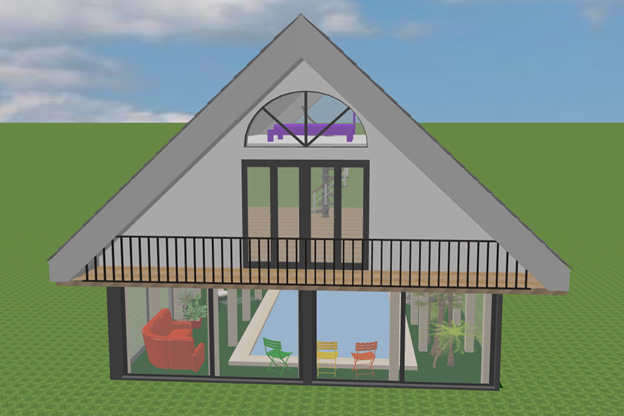
As per our original idea that this is a concept home, we’ve continued to think outside the box. As our main task was to turn architectural excesses into solar electricity, we removed rooms bounded by vertical outer walls. Being a source of cold in winter and heat in summer, we have no regrets removing these outer vertical walls. They actually have the same problems as the walls of a concrete basement on the lower floor – that they need to be plastered, painted, and insulated. For this reason, we’ve decided to also remove them on this level as well.
“Deaf corners” between the inner walls of this particular room and the roof itself, will fill them with heat-insulating material. This will ultimately improve the house’s ability to save energy.
The entrance to the living space can be located both inside the basement via a harmonious spiral staircase in the middle of our jungle, as well as from the outside.
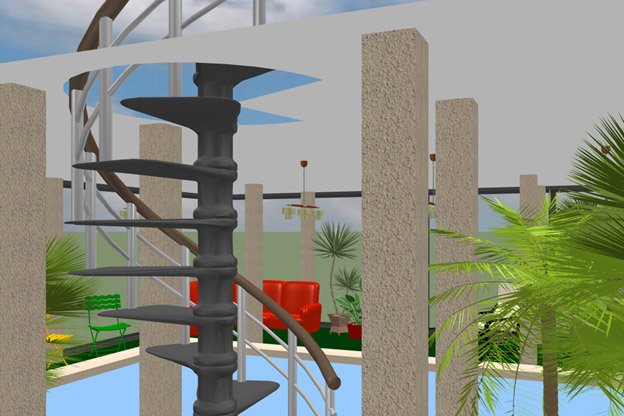
Using the outside stairs we first come to the balcony, and then onto the living room itself. Two entrances and exits will create additional comfort and safety for the residents of the house.
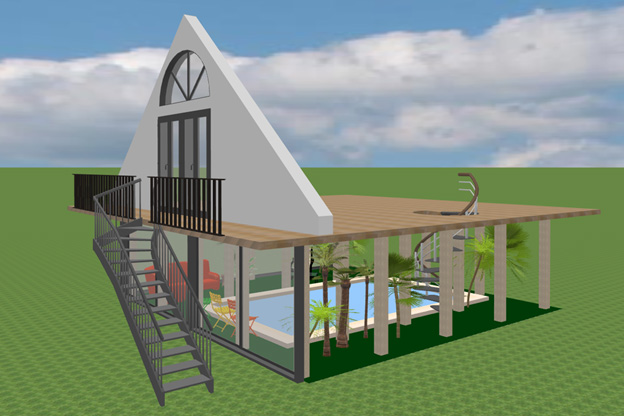
With a gable roof, we have two surfaces that form two of the four outer walls of the main living space. This allowed us to remove two and ultimately increase our efficiency.
Due to its triangular design, using a gable roof rafter system offers us an extremely strong solution. Being securely fastened to the reinforced concrete floor and firmly pressing it to the base, it actually uses gravity to its advantage and becomes even stronger again. From here, we see that the pediments are self supporting and do not actually require any further reinforcement. Not to mention the fact they are able to provide us with the opportunity to generate solar electricity for the house by taking advantage of the surface to mount solar panels. It might be useful to provide pediments with balconies here, but once again this feature is completely at the resident’s discretion. The only consideration here being that as we want to mount solar panels to all possible and impossible places on the outer surface of the house, balcony railings actually provide us with another opportunity. Ultimately it makes sense to ensure balcony railings are inexpensive as the solar panels themselves will perform the same functionality. Again, this corresponds to our plan of intersecting the functions of generating solar power with the building structure itself.
Balconies are also advantageous because they are able to make mounting solar cells more comfortable and allow any required maintenance of panels on the gables without the need to erect temporary scaffolding.
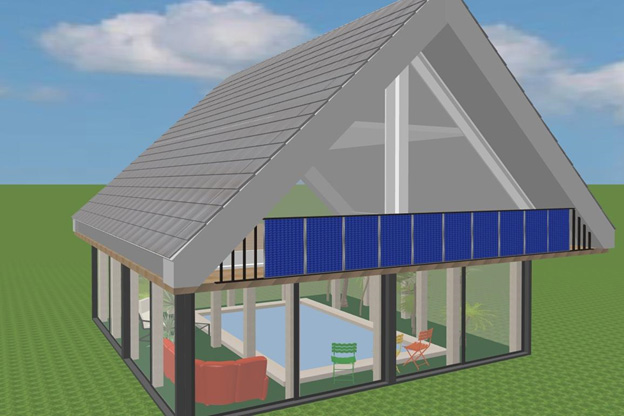
While a frame-type wall made of chipboard with insulation inside may be cheaper, it will require plastering work inside and out. This will eventually equalize the price and over time, erode any initial savings over time. When it comes to the quick installation of windows, it’s up to the resident to decide whether they like a high-tech or “home sweet home” style of home.
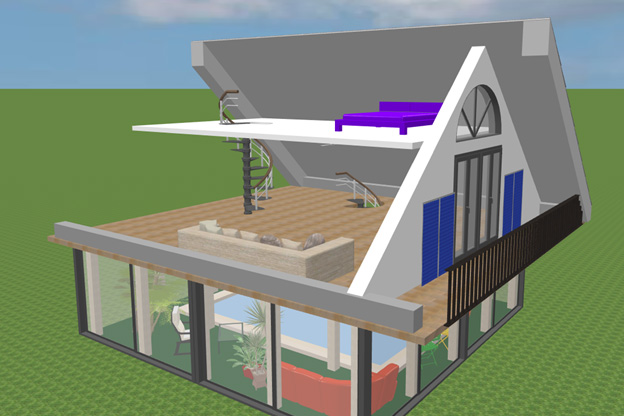
A final consideration around the gables is to possibly make them out of naturally shaped logs. These not only have a low thermal conductivity and an exotic look, but also require minimal ongoing maintenance after installation. Furthermore, modern varnishes and wood paints allow you to maintain a neat appearance over many years.
In order to keep any heat from underneath the floor from accumulating unevenly, you can consider self-leveling floors. But if the owner is an ardent fan of swamp elm parquet, they will have to install additional heating devices.
3. Roof.
In our home design featuring a gable roof, it is actually adjacent to the walls of the rooms. On the one hand, this is a negative because it takes away part of the living space. On the other hand however, this makes it possible for additional insulation. It all depends on the owner’s preference.
The roof serves the function of protecting the house from the elements. In addition, a gabled roof adds character to the design and is often seen as the most spectacular part of the house. As a result, developers spend a considerable amount on roofing materials and their installation. It’s here that we apply our own concept which we call forward to the sun – where we take and cover the entire surface of the roof with solar panels!
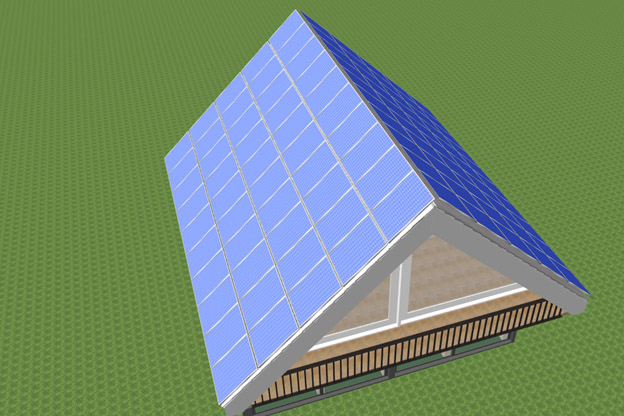
Thanks to the use of solar panels instead of aesthetically pleasing roof tiles, we actually see a huge reduction in the price of roofing and roofing work.
In this particular design, our roof is simply not visible. Therefore, nothing more than a waterproof base such as a shabby slate or a plywood backing, is quite enough.
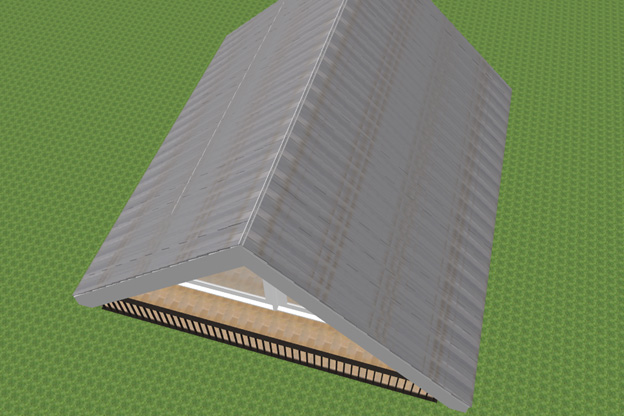
Given that the solar panels on the roof will block solar radiation, rain, hail and snow, we don’t need to focus on the durability of our underlying material quite as much. As a result, any money that would otherwise be spent on the purchase, delivery and installation of tiles or other roofing material, can be redirected to increasing the efficiency of the solar cells themselves.
As there is a range of solar panel sizes to choose from, we’re actually able to cover one hundred percent of the available roof surface. With the exception of windows, hatches, hoods and chimneys of course. But since we are always on the lookout for areas to save on construction costs, of course we’re also able to use standard solar cell sizes if that’s a preference.
The huge surface area of our gabled roof actually allows us to collect a tangible amount of electricity even on cloudy days. Depending on where the house is located, it may be necessary to build a roof with an excessively steep slope. This is because in winter it may get covered with snow and hence our solar power station house will cease to work as planned. In this particular concept home, we’ve set the average slope at around forty-five degrees.
A further consideration could also be the option of a shed style roof. This involves a south facing incline at a calculated angle that allows the solar panels to squeeze the maximum amount of energy out of the sun, no matter where in the sky it is located. If we went down this path, our “sunny house” would definitely catch the attention of passers-by with its notorious futurism. For now however, we have settled on the more familiar outlines of a standard residential building design.
So far, our concept has focused on turning a house into a solar power station in primarily winter conditions. But what about the summer? In the warmer periods of the year, our solar panels will work to cool the building by supplying electricity to air conditioners or other climate control systems. Furthermore, our multi-chamber double-glazed windows will prevent excess heat from entering from the outside. Finally, the pool will serve as an accumulator of excess heat, or even an air cooler if the water in it is forcibly cooled using any excess solar electricity generated in the summer.
Conclusions.
From the research conducted to come up with this concept house built from solar panels, it has become clear that energy-producing, saving and storing housing does not have to follow traditional design principles. Remnants of the past such as foundations, basements, walls and classic roofing don’t have to be adhered to if you don’t want to. Not to mention the fact that a house built with these concepts in mind will require a much shorter construction time, as well as lower investments in equipment and capital. Our solar power station house turned out to be light, airy and even exotic in places. Ultimately providing its residents with a lot of opportunities to live out their fantasies.
To top it off, our concept building will require less money and effort to maintain, while consuming much less energy in the winter. While specifics may vary depending on the size and final location, it even has potential to create a surplus of electricity in summer.
PS. This is how the sun sees our concept house built from solar panels:
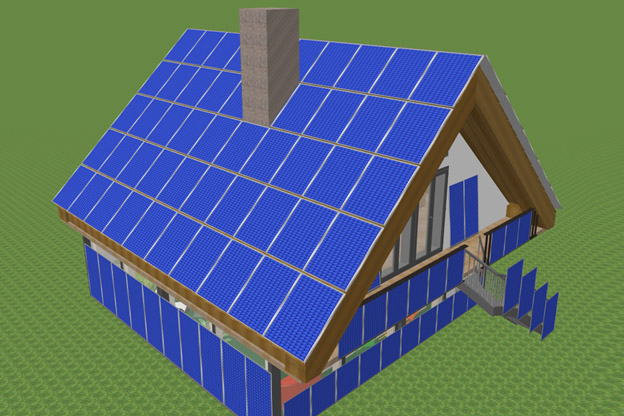
Note
PPS. The article was obviously created in a controversial, but fun manner. Our goal was to evoke all sorts of emotions as you read.
Let us know what you think in the comments below.
